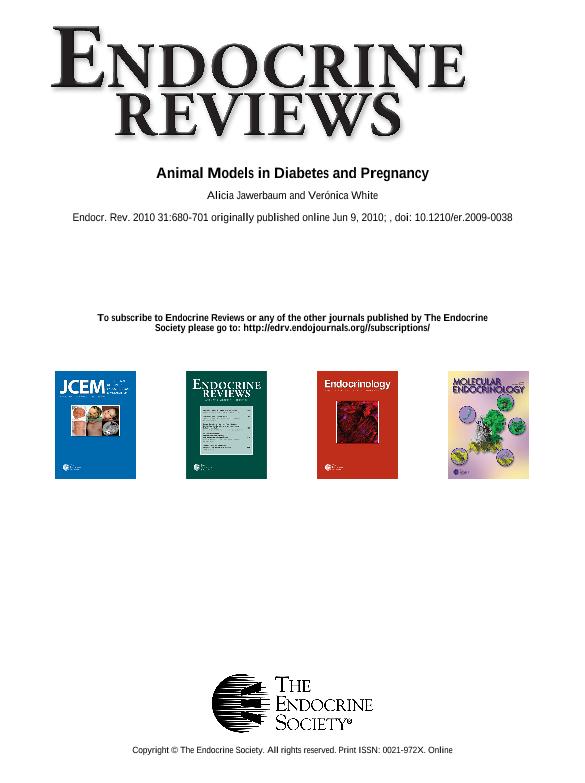Mostrar el registro sencillo del ítem
dc.contributor.author
Jawerbaum, Alicia Sandra

dc.contributor.author
White, Verónica

dc.date.available
2017-06-02T21:30:52Z
dc.date.issued
2010-10
dc.identifier.citation
Jawerbaum, Alicia Sandra; White, Verónica; Animal models in diabetes and pregnancy; Oxford University Press; Endocrine Reviews.; 31; 5; 10-2010; 680-701
dc.identifier.issn
0163-769X
dc.identifier.uri
http://hdl.handle.net/11336/17453
dc.description.abstract
The worldwide increase in the incidence of diabetes, the increase in type 2 diabetes in women at reproductive ages, and the cross-generation of the intrauterine programming of type 2 diabetes are the bases for the growing interest in the use of experimental diabetic models in order to gain insight into the mechanisms of induction of developmental alterations in maternal diabetes. In this scenario, experimental models that present the most common features of diabetes in pregnancy are highly required. Several important aspects of human diabetic pregnancies such as the increased rates of spontaneous abortions, malformations, fetoplacental impairments, and offspring diseases in later life can be approached by using the appropriate animal models. The purpose of this review is to give a practical and critical guide into the most frequently used experimental models in diabetes and pregnancy, discuss their advantages and limitations, and describe the aspects of diabetes and pregnancy for which these models are thought to be adequate. This review provides a comprehensive view and an extensive analysis of the different models and phenotypes addressed in diabetic animals throughout pregnancy. The review includes an analysis of the surgical, chemical-induced, and genetic experimental models of diabetes and an evaluation of their use to analyze early pregnancy defects, induction of congenital malformations, placental and fetal alterations, and the intrauterine programming of metabolic diseases in the offspring’s later life.
dc.format
application/pdf
dc.language.iso
eng
dc.publisher
Oxford University Press

dc.rights
info:eu-repo/semantics/openAccess
dc.rights.uri
https://creativecommons.org/licenses/by-nc-sa/2.5/ar/
dc.subject
Pregnancy
dc.subject
Diabetes Mellitus
dc.subject
Congenital Abnormality
dc.subject
Diabetes Mellitus
dc.subject
Type 2
dc.subject
Gestational Diabetes
dc.subject
Embryo
dc.subject
Fetus
dc.subject
Animal Model
dc.subject
Streptozocin
dc.subject
Placenta
dc.subject
Rats
dc.subject
Diabetes
dc.subject
During Pregnancy
dc.subject
Offspring
dc.subject.classification
Biología Reproductiva

dc.subject.classification
Ciencias Biológicas

dc.subject.classification
CIENCIAS NATURALES Y EXACTAS

dc.title
Animal models in diabetes and pregnancy
dc.type
info:eu-repo/semantics/article
dc.type
info:ar-repo/semantics/artículo
dc.type
info:eu-repo/semantics/publishedVersion
dc.date.updated
2017-05-31T20:04:50Z
dc.journal.volume
31
dc.journal.number
5
dc.journal.pagination
680-701
dc.journal.pais
Reino Unido

dc.journal.ciudad
Oxford
dc.description.fil
Fil: Jawerbaum, Alicia Sandra. Consejo Nacional de Investigaciones Científicas y Técnicas. Oficina de Coordinación Administrativa Houssay. Centro de Estudios Farmacológicos y Botánicos. Universidad de Buenos Aires. Facultad de Medicina. Centro de Estudios Farmacológicos y Botánicos; Argentina
dc.description.fil
Fil: White, Verónica. Consejo Nacional de Investigaciones Científicas y Técnicas. Oficina de Coordinación Administrativa Houssay. Centro de Estudios Farmacológicos y Botánicos. Universidad de Buenos Aires. Facultad de Medicina. Centro de Estudios Farmacológicos y Botánicos; Argentina
dc.journal.title
Endocrine Reviews.

dc.relation.alternativeid
info:eu-repo/semantics/altIdentifier/doi/http://dx.doi.org/10.1210/er.2009-0038
dc.relation.alternativeid
info:eu-repo/semantics/altIdentifier/url/https://academic.oup.com/edrv/article-lookup/doi/10.1210/er.2009-0038
Archivos asociados
